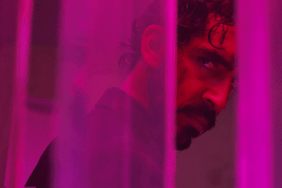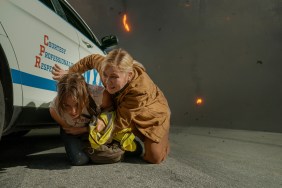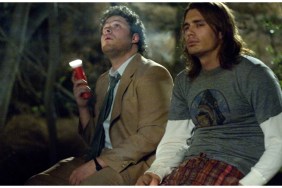Directed by Danny Boyle
Story:
While hiking the Blue John Canyon in Utah, the adventurous Aron Ralston (James Franco) falls into a ravine with his hand caught between a boulder and the canyon wall. With no one around to save him, Ralston spends the next five days trying to survive and reflecting back on his life while trying to figure out a way to escape. (Note: If you don’t know Ralston’s story, there may be some spoilers ahead.)
Analysis:
Anyone who dubs Danny Boyle’s follow-up to his Oscar-winning hit “Slumdog Millionaire,” as “the one in which James Franco cuts his own hand off” is doing “127 Hours” a huge disservice, because there’s a lot more to mountaineer Aron Ralston’s story of survival than just showing how he eventually escaped from what must have seemed like an impossible situation. “127 Hours” isn’t just fascinating for the way it tells Ralston’s story, but also as Danny Boyle’s follow-up to his surprise Oscar winner and like past movies, it seems like a huge departure on paper, but using much of the same crew as “Slumdog,” Boyle has created a film that fits perfectly into his eclectic filmography, often moving at a pace that could only be deemed “kinetic.” That’s certainly the nature of the opening titles, which starts the movie on a global scale before zeroing its focus on hiker Aron Ralston as he plans a trip to the Blue John Canyons in Utah. He isn’t there very long before he meets two co-eds and takes them on an adventure, and shortly after they part ways, Aron falls into a crevasse with a large boulder crushing his hand against the wall trapping him. That’s about 20 minutes in and when the film’s title finally pops up, it’s funny in an unexpectedly irreverent way, although anyone expecting that Ralston’s experience being trapped will feel drawn-out or hard to watch clearly isn’t familiar with Boyle’s work. Over the course of the next 70 minutes, we watch as Ralston does what he can to survive while reflecting back on the family and friends he may never see again. He reflects back on not taking his mother’s phone call, he thinks back to his ex-girlfriend (Clémence Poésy) and how they split up. More than anything, he spends his time trying to figure out how he can free himself and reflecting on what he might have done differently. The range of emotions experienced by Ralston during his ordeal showcases one of James Franco’s finest performances of his career, one where he gets to flex dramatic muscles as well as maintaining the humor and charm he’s brought to so many other recent roles. It’s a great characterization of Ralston as reckless and fun-loving but also practical and resourceful when it counts, fighting the odds in order to survive. Besides working on so many emotional levels, “127 Hours” looks fantastic with Boyle fully exploring the outdoor environment in ways that keeps it from ever getting dull visually. Although Ralston’s situation is one that keeps him in one claustrophobic location for days, that doesn’t hold back Boyle and his team who find ways to explore and expand upon that world. Aaron’s use of video and still cameras shows Aron to be part of the incessant YouTube generation that has to film everything in order to prove it happened, but Boyle uses this opportunity to shoot the film in interesting ways, including something that could only be dubbed as a “waterbottle-cam.” One also can’t help but admire A.R. Rahman’s second musical collaboration with Boyle, creating a score that’s at the same time different from “Slumdog” but also in line with the music of some of Boyle’s best films. When the opening to Bill Withers’ “Lovely Day” kicks in midway, it’s hard not to be reminded of the use of Lou Reed’s “A Perfect Day” in “Trainspotting” and it’s a similarly pitch-perfect movie moment. Five days into Ralston’s experience, when he starts imagining he is the host and guest of his own talk show, one wonders whether maybe things have gone a bit overboard, especially with some of Aron’s crazier hallucinations. Even so, Boyle doesn’t allow the viewer to look away when it comes to Ralston’s courageous escape, a scene that’s gorier and more visceral than anything in the “Saw” series. It’s hard to watch, but it feels necessary to instill that sort of realism into the film after some of the more surreal moments that precede it. The scenes that follow are just as powerful leaving you with a sense of hope as well as an unquenchable desire to explore nature.
The Bottom Line:
A gorgeous film on par with Danny Boyle’s milestone benchmarks, “127 Hours” is a visually-stunning, visceral and emotional experience that makes it one of the year’s best films.










